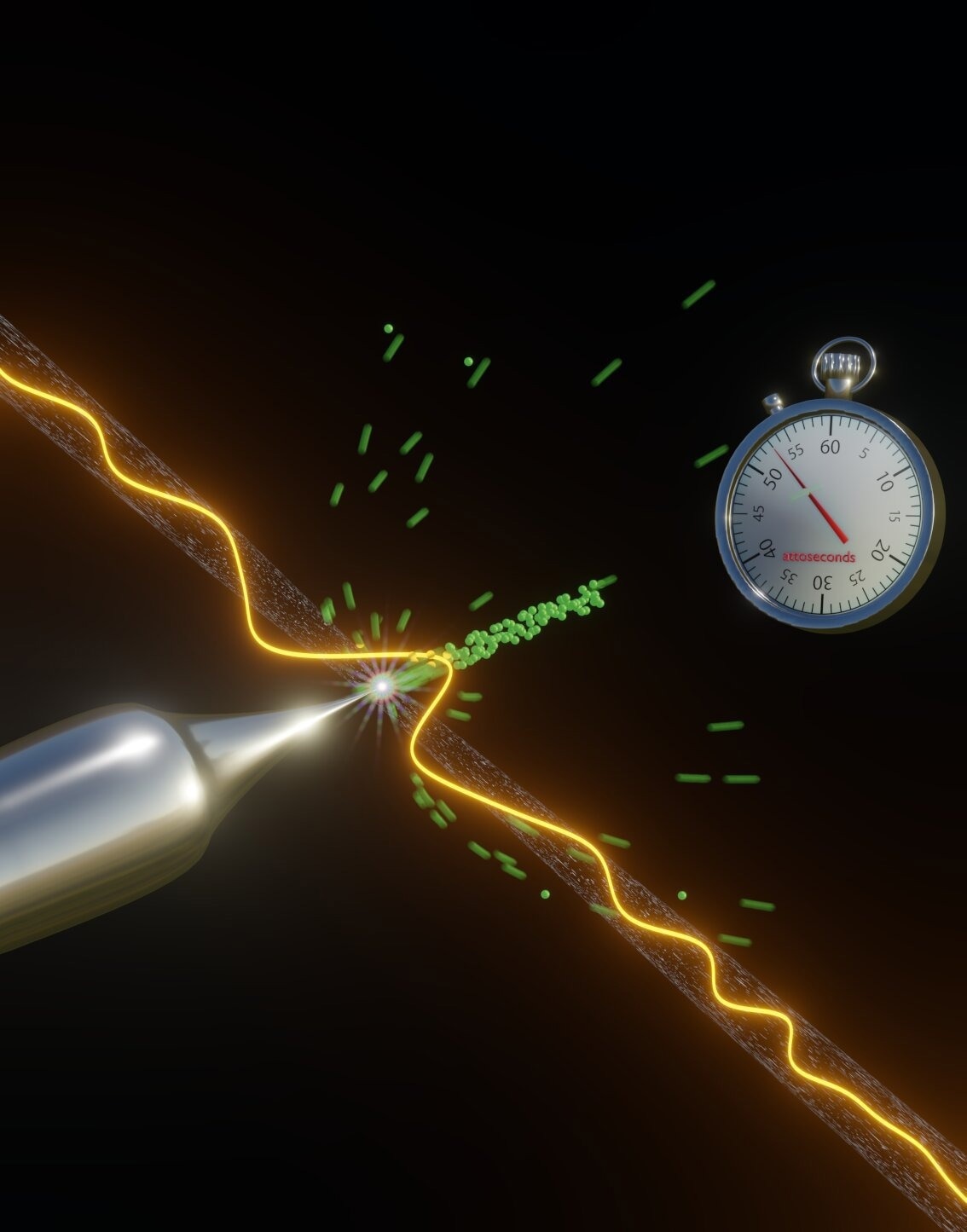Field emission of electrons is a crucial area of study in science and technology, with applications in signal processing and imaging at the atomic scale. Advances in electron microscopy techniques have made it possible to visualize matter on the native spatial and temporal scales of electron dynamics. Still, the analysis of attosecond electron pulses remains a major challenge.

Light pulses emit electrons bursts from a metallic nanotip that last merely 53 attoseconds. Image Credit: Eleftherios Goulielmakis, University of Rostock
A recent article published in the journal Nature focuses on this issue by using intense, sub-cycle light transients to generate optical field emission of electron pulses from tungsten nanotips to directly analyze the emission kinetics in real time.
Field Emission of Electrons: A Brief Overview
Field emission of electrons is a crucial aspect of many scientific and technological advancements, from signal processing at high frequencies to imaging of matter at the atomic scale.
The advancement of electron microscopy techniques has enabled the complete visualization of matter on the native spatial and temporal scales of electron dynamics but requires methods that can confine and examine field emission on sub-femtosecond time intervals.
Intense laser pulses have been used to achieve this by demonstrating femtosecond confinement and sub-optical cycle control of the optical field emission from nanostructured metals. However, the measurement of attosecond electron pulses has remained elusive. Real-time monitoring of electron pulses created in optical field emission is one of the major issues in the area of electron dynamics.
Although typical attosecond streaking methods have been explored to map the temporal information of extreme ultraviolet (EUV) electron excitation from metallic surfaces and nanotips, these methods cannot directly analyze electron pulses appearing in the optical field emission.
Important Challenges in the Field Emission of Electrons
Despite the potential advantages of exploiting electron pulses originating in optical field emission for novel spectroscopies with attosecond temporal and nanometre spatial precision, substantial obstacles remain.
These challenges include the generation of intense, short laser pulses to confine the tunneling of electrons and impart a de Broglie wavelength suitable for atomic-scale investigation, as well as the development of in situ attosecond metrologies that can incorporate temporal gating of the optical field emission without depending on high harmonic radiation.
Current observations have enabled access to the driving-field waveform of light waves and the cut-off energy fluctuation of rescattered electrons. Still, a precise, time-resolved observation of attosecond electron pulses in optical field emission represents a major research gap.
What Did the Researchers Do?
The methodology used in this study includes the analysis of the field emission in tungsten nanotips using intense, sub-cycle optical transients generated in a light-field synthesizer.
The investigations were carried out in a multifaceted experimental setup that integrates atom and solid photoemission spectrometry, optical pump-probe measurement methods, and EUV attosecond flashing for recording driving-field waveforms.
Using a plate sensor, the nonlinearity of the electron yield toward driving-field intensity was examined. The highest peak intensity recorded was 42 TW cm-2, with up to 1000 electrons per pulse.
An emission nonlinearity of 1.18 ± 0.09 was observed, which is less than the multi-photon barrier and confirms the assumption that field-driven electron tunneling controls tungsten ionization. The emission was then studied in the spectrum region under precisely defined driving fields to determine whether it agreed with the assumptions of semiclassical models.
Important Developments
The study presented here has successfully demonstrated the direct measurement of attosecond electron pulses in optical field emission. This achievement extends the range of ultrafast-science tools available for researchers. It opens up new possibilities for tracking ultrafast collective or correlated electron dynamics in various materials deposited or attached to tungsten nanotips.
“Using light pulses that comprise merely a single cycle of its field, it is now possible to give electrons a precisely controlled kick to set them free from the tungsten tip within a very short time interval” explains Eleftherios Goulielmakis, head of the research group.
The recolliding electron pulses can also be used for attosecond-resolved, laser-induced electron diffraction experiments at nanotips, as well as nano-diffraction ex-situ experiments in specimens placed at a nanometric distance from the tip apex.
These advancements could provide new routes for exploring the structure and dynamics of condensed matter in four dimensions. Future research could focus on further developing the technique and applying it to a wide range of materials and systems.
Reference
Kim, H. Y. et al. (2023). Attosecond field emission. Nature. Available at: https://doi.org/10.1038/s41586-022-05577-1
Disclaimer: The views expressed here are those of the author expressed in their private capacity and do not necessarily represent the views of AZoM.com Limited T/A AZoNetwork the owner and operator of this website. This disclaimer forms part of the Terms and conditions of use of this website.